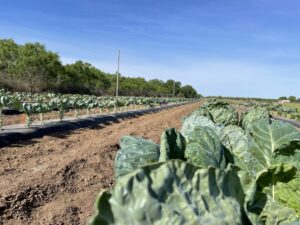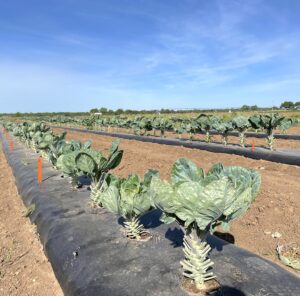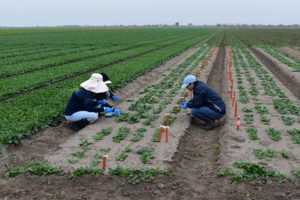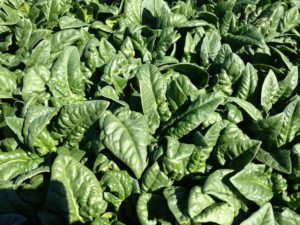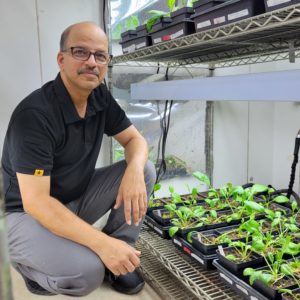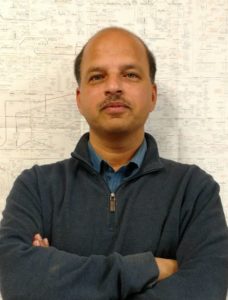Summary
Current Research
Brussels sprout trial
Field evaluation of Brussels sprout diversity panel for natural variation in the nutraceutical components (Glucosinolates) using Genome-Wide Association Studies” (Photo credits- Dalton Thompson)
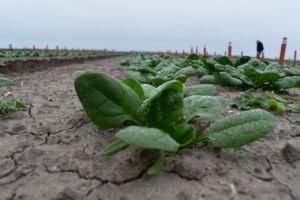 The Systems Plant Physiology program is developing crops with enhanced nutritional qualities and identifying new methods to improve environmental attributes. This program focuses on plant biology and its integrations with micro and macro environments, utilizing physiological, molecular, or metabolic traits to understand associated biological processes. Our broad goal is developing crop varieties with enhanced crop productivity, nutritional qualities and tolerance to abiotic stresses for greater adaptability. The critical areas of research we focus on are:
The Systems Plant Physiology program is developing crops with enhanced nutritional qualities and identifying new methods to improve environmental attributes. This program focuses on plant biology and its integrations with micro and macro environments, utilizing physiological, molecular, or metabolic traits to understand associated biological processes. Our broad goal is developing crop varieties with enhanced crop productivity, nutritional qualities and tolerance to abiotic stresses for greater adaptability. The critical areas of research we focus on are:
-
-
- Nitrogen use efficiency, nitrogen sensing, transport and assimilation
-
- Molecular and genetic aspects of plant metabolism
Advancing the Sustainability Practices of Organic Vegetable Production
Poor productivity of organic crops is in part attributed to the lack of nutrient management strategy, a lack of genetics designed for optimal utilization of resources, and ineffective methods to enhance nutrient uptake. To improve yield stability, we are investigating biochemical aspects of nutrient uptake, their interactions with soil microbiomes and evaluation of nutraceutical potential of organic vegetables for human consumption and processing.
Enhancing the Nutraceutical Potential of Plants
Non-protein amino acid “citrulline” is universal in animals, plants, bacteria, and fungi. It has extensive clinical and therapeutic implications for human and animal health. We focus on many intriguing aspects of its metabolism; such as synthesis, regulation, long-distance transport, its role as an N-carrier, and as an osmolyte using molecular and metabolic cues. We are using Arabidopsis and watermelon systems to characterize citrulline metabolism.
Enhancing the nutrient use efficiency of plants
The leaching of excessive nitrogenous fertilizers applied to commercial crops leads to environmental problems. To understand the dynamics of nutrient use efficiency we are using cutting-edge tools in genomics to identify spinach genotypes efficient in nutrient uptake, assimilation, utilization. We are using natural variation as a tool to identify the genetic variation for the anti-microbial compounds in spinach and variation in the indigenous microbiota for it’s effectiveness against food-borne pathogens.
Dr. Vijay Joshi
Team Members
Dhivya Thenappan – Postdoctoral Research Associate
Benedict Analin – Postdoctoral Research Associate
Dalton Thompson – Research Technician I
Sandeep Kaur Sran – Graduate Assistant Research
Sri Kiran Reddy – Graduate Assistant Research
Ryan Garcia – Non-Affiliated Student Assistant
Past Members
Moazzameh Ramezani – Postdoctoral Research Associate
Amit Kumar Mishra – Postdoctoral Research Associate
Qiushuo Song, – MS Student (Kudos to Ms. Qiushuo Song on her graduation)
Matté Moreno – Non-Affiliated Student Assistant
Publications
Publications(* corresponding author)
- Lee, C., Harvey, J.T., Qin, K., Joshi, V., and Leskovar, D.I. (2024) Exploring the potential of Solanum pennellii and Solanum peruvianum as rootstocks for enhancing thermotolerance of tomato plants. Environmental and Experimental Botany 221: 105741. https://doi.org/10.1016/j.envexpbot.2024.105741
- Formiga, AK, Joshi, V, Colley, M (2024) Challenges in the market for organic spinach seed. https://eorganic.org/node/35758
- Ramezani M, Thompson D, Moreno M and Joshi V* (2023) Biochemical repercussions of light spectra on nitrogen metabolism in spinach (Spinacia oleracea) under a controlled environment. Front. Plant Sci. 14:1283730. doi: 10.3389/fpls.2023.1283730
- S Bhattarai, JT Harvey, C Lee, V Joshi, DI Leskovar (2024) Assessment of physiological and biochemical thermotolerance traits in tomato genotypes. Scientia Horticulturae, 324, 112561. https://doi.org/10.1016/j.scienta.2023.112561
- Pandey J, Thompson D, Joshi M, Scheuring D, Koym J, Joshi V*, Vales M* (2023) Genetic architecture of tuber-bound free amino acids in potato and effect of growing environment on the amino acid content. Scientific Reports 13:13940. https://doi.org/10.1038/s41598-023-40880-5
- Tolley, JP, Gorman Z, Lei J, Yeo I, Nagashima Y, Joshi V, Zhu-Salzman K, Kolomiets MV, Koiwa H*(2022) Overexpression of maize ZmLOX6 in Arabidopsis thalianaenhances damage-induced pentyl leaf volatile (C5) emissions that affect plant growth and interaction with aphids, Journal of Experimental Botany erac522 https://doi.org/10.1093/jxb/erac522
- Joshi, V*., Shi, A., Mishra, A.K. et al. Genetic dissection of nitrogen induced changes in the shoot and root biomass of spinach (2022). Scientific Reports 12, 13751. https://doi.org/10.1038/s41598-022-18134-7
- Ainong Shi, Gehendra Bhattarai, Haizheng Xiong, Carlos A Avila, Chunda Feng, Bo Liu, V Joshi, Larry Stein, Beiquan Mou, Lindsey J du Toit, James C Correll (2022) Genome-wide association study and genomic prediction of white rust resistance in USDA GRIN spinach germplasm, Horticulture Research, Volume 9, 2022, uhac069, https://doi.org/10.1093/hr/uhac069
- Islam ASMF, Sanders D, Mishra AK, Joshi V* (2021) Genetic diversity and population structure analysis of the USDA olive germplasm using Genotyping-By-Sequencing (GBS). Genes,12 https://doi.org/10.3390/genes12122007
- Joshi V*, Nimmakayala P, Song Q, Abburi V, Natarajan P, Levi A, Crosby K, Reddy UK* (2021) Genome-wide association study and population structure analysis of seed-bound amino acids and total protein in watermelon. 9: e12343. https://doi.org/10.7717/peerj.12343
- Alves FM, Joshi M, Djidonou D, Joshi V, Gomes CN, Leskovar D* (2021) Physiological and Biochemical Responses of Tomato Plants Grafted onto Solanum pennelliiand Solanum peruvianum under Water-deficit Conditions. Plants, 10, 2236. https://doi.org/10.3390/plants10112236
- Canarejo-Antamba M, Banuelos-Tavares O, Reyes-Trejo B, Espinosa-Solares T, Joshi V, Guerra- Ramirez D (2021) Comparison of nutritional and nutraceutical properties of Chenopodium quinoacultivated in Mexico and Ecuador. Chilean Journal of Agricultural Research. 81, 04. https://doi:10.4067/S0718-58392021000400507
- Joshi V*, Penalosa A, Joshi M, Rodriguez S (2021) Regulation of oxalate metabolism in spinach revealed by RNA-Seq-based transcriptomic analysis. International Journal of Molecular Sciences.22, 5294. https://doi.org/3390/ijms22105294
- Awika HO, Mishra A, Gill H, DiPiazza J, Avila C, Joshi V*(2021) Selection of nitrogen responsive root architectural traits in spinach using machine learning and genetic correlations. Scientific Reports. 11, https://doi.org/10.1038/s41598-021-87870-z
- Song Q, Joshi M, Wang S, Johnson C, Joshi V* (2020)Comparative analysis of root transcriptome profiles of sesame (Sesamum indicum) in response to osmotic stress. Journal of Plant Growth https://doi.org/10.1007/s00344-020-10230-0
- Song Q, Joshi M, Joshi V* (2020) Transcriptomic analysis of short-term salt stress response in watermelon seedlings. International Journal of Molecular Sciences21, 6036. https://doi.org/10.3390/ijms21176036
- Song Q, Joshi M, DiPiazza J, Joshi V* (2020) Functional relevance of citrulline in the vegetative tissues of watermelon during abiotic stresses. Frontiers in Plant Science. https://doi.org/10.3389/fpls.2020.00512
- Joshi V*,Joshi M, Penalosa A (2020) Comparative analysis of tissue-specific transcriptomic responses to nitrogen stress in spinach (Spinacia oleracea). PLOS ONE. 15, e0232011 https://doi.org/10.1371/journal.pone.0232011
- Shi T, Joshi V, Joshi M, Vitha S, Gibbs H, Wang K, Okumoto S (2019) Broad-spectrum amino acid transporters ClAAP3 and ClAAP6 expressed in watermelon fruits. International Journal of Molecular Sciences. 20(23) pii: E5855 https://doi.org/10.3390/ijms20235855
- Awika HO, Cochran K, Joshi V, Bedre R, Mandadi KK, Avila CA (2019) Single‐marker and haplotype‐based association analysis of anthracnose (Colletotrichum dematium) resistance in spinach (Spinacia oleracea). Plant Breeding.139 (2): 402–18 https://doi.org/10.1111/pbr.12773
- Joshi V, Shinde S, Nimmakayala P, Abburi VL, Alaparthi SB, Lopez-Ortiz C, Levi A, Panicker G, Reddy UK (2019) Haplotype networking of GWAS hits for citrulline variation associated with the domestication of watermelon. International Journal of Molecular Sciences. 20, 5392 https://doi.org/10.3390/ijms20215392
- Joshi V*, Joshi M, Silwal D, Noonan K, Rodriguez S, Penalosa A (2019) Systematized biosynthesis, and catabolism regulates citrulline accumulation in watermelon. 162: 129-140. https://doi.org/10.1016/j.phytochem.2019.03.003
- Joshi V*, Fernie A (2017) Citrulline Metabolism in Plants. Amino Acids49(9): 1543-1559 https://doi.org/10.1007/s00726-017-2468-4
- Huang T, Joshi V, Jander G (2014) The catabolic enzyme MGL methionine gamma-lyase limits methionine accumulation in potato tubers. Plant Biotechnology Journal.12(7): 883-893 https://doi.org/10.1111/pbi.12191
- Adio AM, Casteel CL, De Vos Martin, Kim J, Joshi V, Li B, Juéry C, Daron J, Kliebenstein DJ, Jander G. (2011) Biosynthesis and defensive function of Nδ-acetylornithine, a jasmonate-induced Arabidopsis metabolite.Plant Cell. 23(9):3303 https://doi.org/10.1105/tpc.111.088989
- Jander G, Joshi V(2010) Deciphering the biosynthesis of aspartate-derived amino acids in plants: Metabolic networks and molecular mechanisms. Molecular Plant 3:54-65 https://doi.org/10.1093/mp/ssp104
- Joshi V*, Joung J, Fei Z, Jander G (2009) Transcriptional regulation and synthesis of branched chain amino acids as osmolytes in plants under drought and cold stress. Amino Acids.39(4):933-47 https://doi.org/10.1007/s00726-010-0505-7
- Joshi V, Jander G (2009) Arabidopsis thaliana methionine gamma-lyase is regulated according to isoleucine biosynthesis needs but plays a subordinate role to threonine deaminase. Plant Physiology. 151:367-378. https://doi.org/10.1104/pp.109.138651.
- Jander G, Joshi V(2009) Aspartate-derived amino acid biosynthesis in Arabidopsis thaliana. The Arabidopsis Book, Rockville, MD: American Society of Plant Biologists 7, e0121 https://doi.org/10.1199/tab.0121
- Joshi V, Laubengayer K, Schauer N, Fernie A, Jander G (2006) Two Arabidopsis threonine aldolases are non-redundant and compete with threonine deaminase for a common substrate pool. Plant Cell. 18: 3564-3575. https://doi.org/10.1105/tpc.106.044958
- Jander G, Norris SR, Joshi V, Fraga M, Rugg A, Yu S, Li L, Last R (2004) Application of a high throughput HPLC-MS/MS assay to Arabidopsis mutant screening; evidence that threonine aldolase plays a role in seed nutritional quality. Plant Journal.39 (3) 465-475. https://doi.org/10.1111/j.1365-313X.2004.02140.x
- Telang M, Srinivasan A, Patankar A, Harsulkar A, Joshi V, Damle A, Deshpande V, Sainani M, Ranjekar P, Gupta G, Birah A, Rani S, Kachole M, Giri A, Gupta V (2003) Bitter gourd proteinase inhibitors: potential growth inhibitors of Helicoverpa armigeraand Spodoptera litura. 63(6) 643-652 https://doi.org/10.1016/S0031-9422(03)00239-5
- Joshi V*, Ugale SD (2002) Involvement of higher order gene interactions addressing complex polygenetically controlled the inheritance of downy mildew (Sclerospora graminicolaS), resistance in pearl millet (Pennisetum glaucum). 127(2): 149-161 https://doi.org/10.1023/A:1020220309074
Grants
- Grant #1

